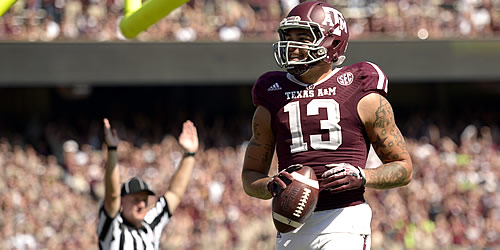As we begin the countdown to the NFL Draft starting on May 8, I will spend anywhere from 4-8 hours to break down the strengths and weaknesses of at least the top 20 or so offensive skill-position prospects available in this draft.

Mike Evans: Vincent Jackson’s frame and Brandon Marshall’s game.
Vitals
College: Texas A&M
Height/Weight: 6’5”/232
Hands: 9 1/2”
Important NFL Combine Numbers
40-Yard Dash: 4.53
Vertical Jump: 37”
Broad Jump: N/A
20-Yard Shuttle: 4.26
3-Cone: 7.08
Background (College Stats)
Evans was a bit more of a basketball phenom in his high-school days, only playing football in his senior year. However, he proved to be a quick study in the Aggies’ spread attack in 2012 after taking a redshirt year, leading Texas A&M with 82 receptions for 1,105 yards (both school freshman records) and five touchdowns. Evans’ catch numbers dropped in 2013, but spiked almost everywhere else, posting a 69-1,394-12 line (breaking former teammate Ryan Swope’s single-season record for receiving yardage) in an offense that saw four receivers record at least 51 catches. Although the first-team All-SEC receiver tore apart Alabama for 279 yards earlier in the year, his finest game came against national champion runner-up Auburn, which he burned for 11 receptions, a school-record 287 yards and four touchdowns. Those games allowed Evans to become the first player in school history to register two 200-yard receiving games in his career. Unfortunately, the Biletnikoff Award finalist ended his college career on a bit of a mixed note. Evans picked up two 15-yard penalties in the first quarter of the Aggies’ thrilling comeback win in the Chick-fil-A Bowl after getting on officials for a lack of a pass interference call in the end zone against Duke CB (and fellow 2014 draft classmate) Ross Cockrell. The second infraction likely was a carryover from the first no-call (as well as continued physical play from Cockrell), suggesting the mean streak Evans uses to his advantage so often can also manifest itself in a negative way as well.
NFL Player Comp(s): Vincent Jackson’s frame and Brandon Marshall’s game
Strengths
- Highly physical receiver that uses his size and strength well; challenges defenders to tackle him but displays enough elusiveness in the open field to make the first man miss.
- Large catch radius given his size and wingspan, shows exceptional hands on 50/50 balls and is perhaps the best combination red-zone/deep threat in this draft.
- Master at the fade-stop and displays great body control as well as an innate ability to time “high-point” throws.
- Stacks the defender well on deep throws and can catch over either shoulder.
- Is not the best run-after-catch threat in his class, but has a good stiff-arm and more than enough power to run through or drag tacklers.
- Gives consistent effort on pass plays whether or not he is the target and is also a willing run blocker who can flatten his defender on occasion.
- Was often the target for QB Johnny Manziel when plays broke down, making himself an inviting option by using “scramble-drill” techniques and boxing out the defender when necessary.
Weaknesses
- Could face a long learning curve in learning a NFL offense since Texas A&M did not use a pro-style offense; most of his production came on jump balls, screens, fade-stops or go routes.
- Rides a fine line between pushing off defender while ball is in the air and creating separation with his size; earned a reputation among SEC coaches that he grabbed cornerbacks during a route to get an extra “boost”.
- Final college game displayed a bit of an uneven temperament and that a defender (or referee) can rattle him.
- Allows the ball get into his body a bit too often, mostly on short and intermediate throws.
- Ends up near the sideline too often before he can make a play on the ball, thereby making a difficult downfield throw even more so for his quarterback.
- A bit of long-strider and a bit slow coming out of breaks (common for a receiver of his size), which may lend itself to a lot of contested catches in the NFL.
Bottom Line
Some bigger receivers act as if they have been told not to be overly physical because they have always been bigger than all the other kids; Evans has no such problem and actually plays with a bit of mean streak. He should make an immediate impact as a red-zone threat given the pro game’s love for the fade pattern in the scoring area as well as the deep passing game with his size and leaping ability. That’s the good news. The glass-half-empty view would suggest that his college offense may have stunted his growth as a student of the game because so much of the Aggies’ attack was based on Manziel’s ability to create something out of nothing. It’s hardly a fatal flaw, however, since just about any position coach would prefer having a receiver with Evans’ measurables and competitive drive (and teach him how to be a pro receiver) as opposed to taking on a refined route-runner without his unique qualities. Evans is going to be an instant starter in the NFL for the simple fact he is a matchup nightmare all over the field. It is scary to think Evans is a relatively raw 20-year-old who didn’t begin playing football until his senior year of high school. Clemson’s Sammy Watkins may be the better draft prospect in the short term, but no one should be surprised if Evans ends up being every bit as good – if not better – than his esteemed draft classmate once he becomes a more polished receiver.
